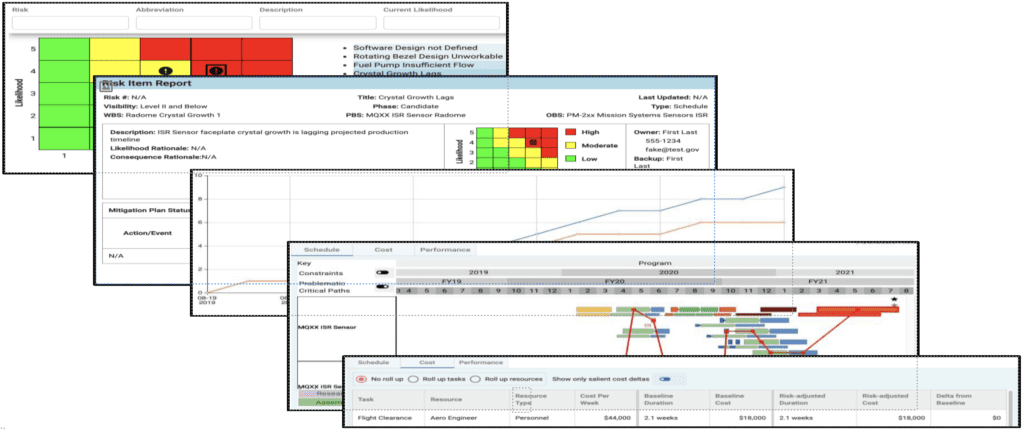Business Operations Streamlining System (BOSS)
`Program management tool for risk and issue identification, tracking, and response generation.
The Business Operations Streamlining System (BOSS) helps users manage complex programs more effectively. Using AI and machine learning, BOSS monitors and interprets internal and external data and documents to track program progress. Using knowledge about schedules, budgets, technologies, contractors, recognizes potential problems early and helps frame effective responses swiftly.
Target Users Include
• Acquisition Program Managers (PMs) – e.g., NAVAIR PMAs
• Program office staff down to Integrated Product Team (IPT) leads
• Potential for links to (or customized version for) PMs at prime contractors
Capabilities → Features → Benefits

• Help Brainstorm Risks: BOSS supports initial risk register creation and ongoing augmentation by using case-based reasoning (CBR) techniques to exploit risk histories and other data from past programs. This results in more complete identification of program risks at an earlier stage. If a risk is identified early enough, data and reporting deliverables for monitoring risk status can be inserted into contracts. (Development of this capability is planned. Others in this list have been prototyped.)
• Monitor Risks / Identify Issues: BOSS tracks structured data and unstructured information from within a program office, from contractors, and the outside world. It extracts meaningful trends and identifies threats to program performance thresholds to produce early warnings and impact projections.
• Support Program Risk Assessment Board (PRAB) Meetings: BOSS provides filterable interactive visualizations of risks, issues, and opportunities, with mitigation plans, program status, and data trends. It facilitates preparation, discussion, drilldown, and action items associated with PRAB meetings. This results in more efficient and better-informed decision-making.
• Forecast Consequences: BOSS forecasts consequences of risks and emerging issues by applying the Aurora intelligent scheduling engine based on data trends. Clear presentations of schedule and cost impact highlighting critical paths and plan deviations provides insight that enables effective prioritization.
• Explore Responses: BOSS supports the exploration of mitigation and response plans, again by combining intelligent scheduling and interactive visualizations. BOSS also automatically suggests and explores response strategies to quickly identify responses that lower costs and improve program results.
➢ Informed Analysis/Views: Bottom line: BOSS’ automated analyses and interactive views, informed by the integration of relevant data, facilitate rapid program understanding that leads to better program results.
Sample Scenarios
• Task running behind schedule threatens program timeline to initial operational capability (IOC).
• Diminishing Manufacturing Sources and Material Shortages (DMSMS) issue due to a trade war.
Detailed Scenario: Notional MQXX program
• MQXX is an unmanned high-endurance/long-range carrier-launched air vehicle
• Sensor suite includes passive high-resolution ISR sensor
• ISR sensor requires crystal faceplate/radome of unusual size and complexity
• Challenge of faceplate crystal growth identified as risk during pre-solicitation market research
• PRAB defines faceplate growth risk with pre-planned mitigations including contractor data delivery
• ISR development plan includes 1 proof-of-concept, 2 lab-test, and 4 dev-test faceplate articles
• Figure below shows critical path to developmental test for MQXX ISR sensor

BOSS’ Contribution
• BOSS tracks actual crystal growth versus plan (at right)
• BOSS notices deviation from plan early
• Automated analysis and notification escalates the issue
• Automated scheduling highlights milestone and cost impacts
• Automated strategies identify options to get back on track

Point of Contact
– Eric Domeshek
– domeshek@stottlerhenke.com
– 617-945-8350
